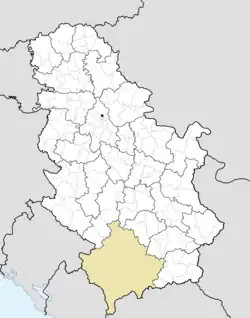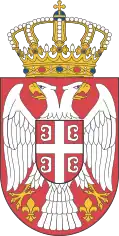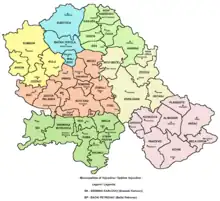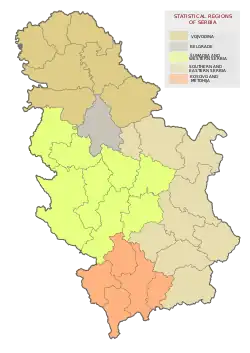| Municipalities and cities of Serbia Општине и градови Србије Opštine i gradovi Srbije | |
|---|---|
 Municipalities and cities of Serbia | |
| Category | Unitary state |
| Location | Republic of Serbia |
| Created by | Decree of 29 January 1992 |
| Created |
|
| Number | 145 municipalities + 29 cities 117 municipalities + 28 cities (de facto, excluding Kosovo) (as of 2018) |
| Populations | 1,663 (Crna Trava) – 1,659,440 (Belgrade) |
| Areas | 20 sq mi (51 km2) (Sremski Karlovci) – 1,245 sq mi (3,225 km2) (Belgrade) |
| Government |
|
| Subdivisions |
|
 |
|---|
|
|
The municipalities and cities (Serbian: општине и градови, romanized: opštine i gradovi) are the second level administrative subdivisions of Serbia. The country is divided into 145 municipalities (Serbian: opštine, singular: opština; 38 in Southern and Eastern Serbia, 42 in Šumadija and Western Serbia, 37 in Vojvodina and 28 in Kosovo and Metohija) and 29 cities (Serbian Latin: gradovi, singular: grad; 9 in Southern and Eastern Serbia, 10 in Šumadija and Western Serbia, 8 in Vojvodina and one in Kosovo and Metohija), forming the basic level of local government.[1][2]
Municipalities and cities are the administrative units of Serbia, and they form 29 districts in groups, except the City of Belgrade which is not part of any district.
A city may and may not be divided into city municipalities (Serbian: gradske opštine, singular: gradska opština) depending on their size. Currently, there are six cities in Serbia with city municipalities: Belgrade, Novi Sad, Niš, Požarevac, Užice and Vranje comprise several city municipalities each, divided into "urban" (in the city proper) and "other" (suburban). There are 30 city municipalities (17 in Belgrade, 5 in Niš, and 2 each in Novi Sad, Požarevac, Užice and Vranje).[3]
Definition
Municipalities and cities
- Municipalities
Like in many other countries, municipalities are the basic entities of local government in Serbia. The head of the municipality is the President of the municipality, while the executive power is held by the Municipal council, and legislative power by the Municipal assembly. Municipal assembly is elected on local elections (held every 4 years), while the President and the Council are elected by the Assembly. Municipalities have their own property (including public service companies) and budget. Only the cities officially have mayors (Serbian: gradonačelnici), although the municipal presidents are often informally referred to as such.
The territory of a municipality is composed of a town (seat of the municipality) and surrounding villages (e.g. the territory of the Municipality of Čoka is composed of the town of Čoka, which is the seat of the municipality, and surrounding villages). The municipality bears the name of the seat town. Only one municipality (Municipality of Gora) does not share the name with the seat town, as the seat of that municipality is the town of Dragaš. This municipality is located in Kosovo, and thus exists only on paper. The territory of the municipality was merged with part of the Municipality of Prizren in 2000 by UNMIK to form new Municipality of Dragaš. This move is not recognised by Serbian Government (see Municipalities and cities of Kosovo section).
Advocates of reform of Serbian local self-government system point out that Serbian municipalities (with 50,000 citizens in average) are the largest in Europe, both by territory and number of residents, and as such can be inefficient in handling citizens' needs and distributing the income from the country budget into most relevant projects.[4][5]
- Cities and city municipalities
Cities are another type of local self-government. The territory with the city status usually has more than 100,000 inhabitants,[1] but is otherwise very similar to municipality. There are 27 cities (Serbian: gradovi, singular: grad), each having an assembly and budget of its own. Only the cities have mayors (Serbian Latin: gradonačelnici, singular: gradonačelnik), although the presidents of the municipalities are often referred to as "mayors" in everyday usage.
As with a municipality, the territory of a city is composed of a city proper and surrounding villages (e.g. the territory of the City of Subotica is composed of the Subotica town and surrounding villages). Every city (and municipality) is part of a district. The exception is the capital Belgrade, which is not part of any district.[6]
The city may or may not be divided into city municipalities. Six cities: Belgrade, Novi Sad, Niš, Požarevac, Užice and Vranje comprise several city municipalities. Competences of cities and these municipalities are divided. The municipalities of these cities also have their assemblies and other prerogatives. Two largest city municipalities by number of residents are the Novi Sad (307,760) and New Belgrade (212,104).[7]
Of these six cities, only Novi Sad did not undergo the full transformation, as the newly formed municipality of Petrovaradin exists pretty much only formally;[8] thus, the City municipality of Novi Sad is largely equated to city of Novi Sad. The city of Kragujevac had its own city municipalities from 2002 until 2008. In 2013, the city municipality of Sevojno within the city of Užice was established.[9]
Municipalities and cities of Kosovo
Serbian law still treats Kosovo as an integral part of Serbia (officially the Autonomous Province of Kosovo and Metohija), although Kosovo declared independence in 2008. The Law on Territorial Organization defines 28 municipalities and 1 city on the territory of Kosovo.[1] Kosovo was under official United Nations' administration (UNMIK) from 1999 to 2008. The UNMIK administration changed the territorial organisation on the territory of Kosovo. In 2000 the municipality of Gora was merged with Opolje (part of the Municipality of Prizren) into the new municipality of Dragaš and one new municipality was created: Mališevo. Later, from 2005 to 2008, seven new municipalities were created: Gračanica, Elez Han, Junik, Parteš, Klokot, Ranilug and Mamuša.[10] However, the Government of Serbia does not recognise the territorial re-organisation of Kosovo, although some of these new-formed municipalities have Serb majority, and some Serbs participate in local elections. In three of those municipalities: Gračanica, Klokot-Vrbovac and Ranilug, Serbian parties won a majority in the 2009 elections.[11][12]
In the Brussels Agreement, in 2013, Serbia agreed to disband its parallel municipal institutions in Kosovo, while the authorities of Kosovo agreed on creation of the Community of Serb Municipalities. However, both parties acted slowly to put this agreement in power.[13][14]
List of municipalities
This is a list of the municipalities in Serbia, as defined by the Law on territorial organisation[1] It does not include municipalities in Kosovo created by UNMIK after 1999. The data on population is taken from the 2011 census.[7]
The census was not conducted in Kosovo, which is under administration of UNMIK, so the population numbers are not given for the municipalities in Kosovo.
List of cities and city municipalities
See also
References
- 1 2 3 4 "Закон о територијалној организацији Републике Србије" [Law on the Territorial Organisation of the Republic of Serbia]. Службени гласник Републике Србије (129): 3–41. 2007. ISSN 0353-8389.
"Закон о изменама и допунама Закона о територијалној организацији Републике Србије" [Law on the Amendment of the Law on the Territorial Organisation of the Republic of Serbia]. Службени гласник Републике Србије (18): 32–34. 2016. ISSN 0353-8389. - ↑ "Pirot, Kikinda i Vršac dobili status grada" [Pirot, Kikinda and Vršac Awarded City Status]. B92. 29 February 2016. Retrieved 5 March 2016.
- 1 2 "2011 Census of Population, Households and Dwellings in the Republic of Serbia" (PDF). Statistical Office of the Republic of Serbia. ISSN 0354-3641. Retrieved 21 November 2011.
- ↑ Jerinić, Jelena (2006-12-01). "Konkretni oblici učešća građana" (PDF). Lokalna samouprava (in Serbian). Permanent conference of cities and municipalities/Vreme. p. 6. Archived from the original (PDF) on March 10, 2007. Retrieved 2007-07-31.
- ↑ "Local Communities in Serbia: How to Become an Effective Voice for Citizens". USAID/Serbia Local Government Report Program. 2004-07-01. p. 4. Archived from the original (pdf) on 2011-07-27. Retrieved 2007-07-31.
- ↑ "Уредба о управним окрузима" [Regulation on Administrative Districts]. Службени гласник Републике Србије (15): 3–6. 2006. ISSN 0353-8389.
- 1 2 Comparative overview of the number of population in 1948, 1953, 1961, 1971, 1981, 1991, 2002 and 2011, pod2.stat.gov.rs; accessed 15 October 2016.
- ↑ Mijušković, Miroljub (13 August 2012). "Petrovaradin traži pravu opštinu". politika.rs (in Serbian). Retrieved 22 March 2017.
- ↑ "ОДЛУКА О ИЗМЕНАМА И ДОПУНАМА СТАТУТА ГРАДА УЖИЦА" (PDF). graduzice.org (in Serbian). Службени лист града Ужица. Archived from the original (PDF) on 4 March 2016. Retrieved 22 March 2017.
- ↑ "Municipal profiles". Organization for Security and Co-operation in Europe.
- ↑ "UNMIK: Serb boycott creates new problems". B92. 22 November 2007. Archived from the original on 8 June 2011. Retrieved 4 December 2009.
- ↑ "Srbima većina u tri opštine" (in Serbian). B92. 16 November 2009. Retrieved 4 December 2009.
- ↑ "Kosovo Accuses Serbia of Delaying Brussels Agreement". Balkan Insight. 24 March 2015. Retrieved 4 May 2015.
- ↑ Morina, Die (21 November 2016). "Kosovo Stalls on Serbian Municipal Association". balkaninsight.com. BIRN. Retrieved 19 March 2017.
- 1 2 As given in the Law, in Serbian Cyrillic order
- Municipalities of Serbia 2008, Statistical Office of Serbia, issued January 2009, ISSN 1452-4856 (Public Domain, see template:PD-SerbiaGov)


